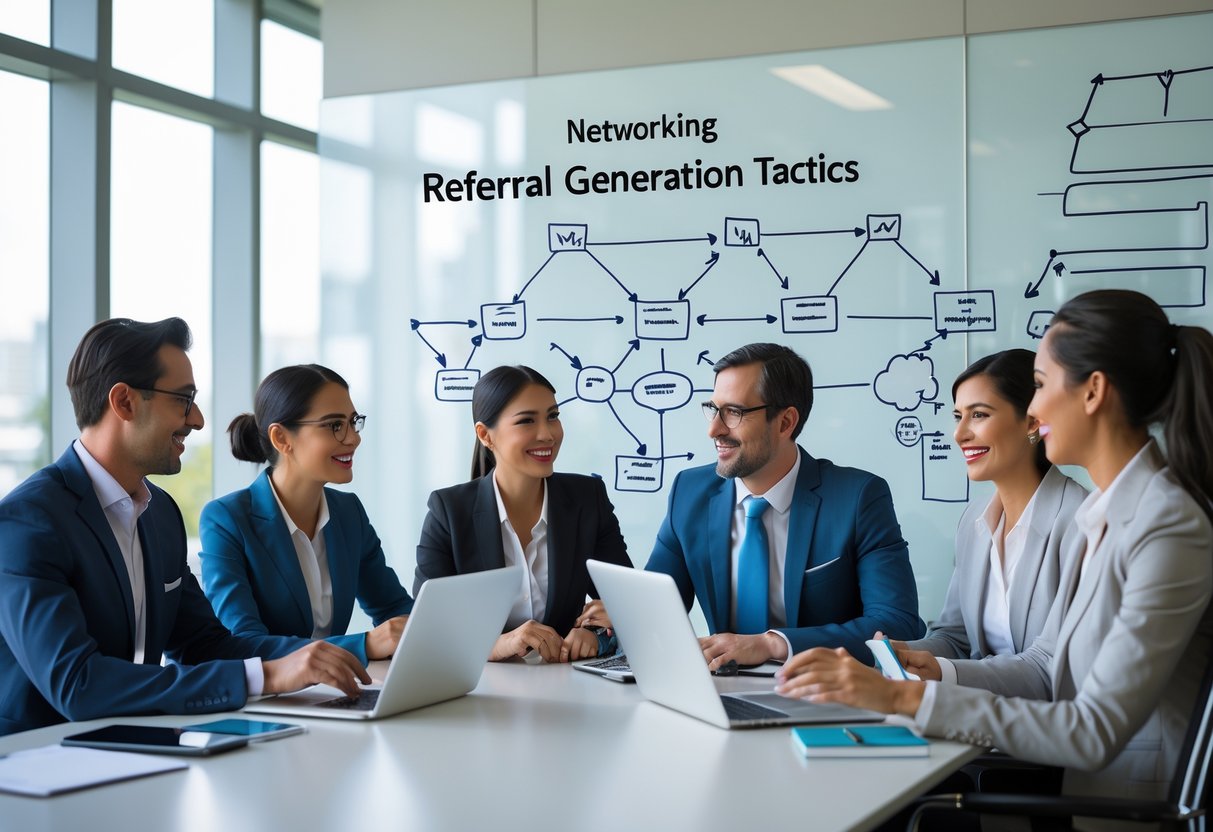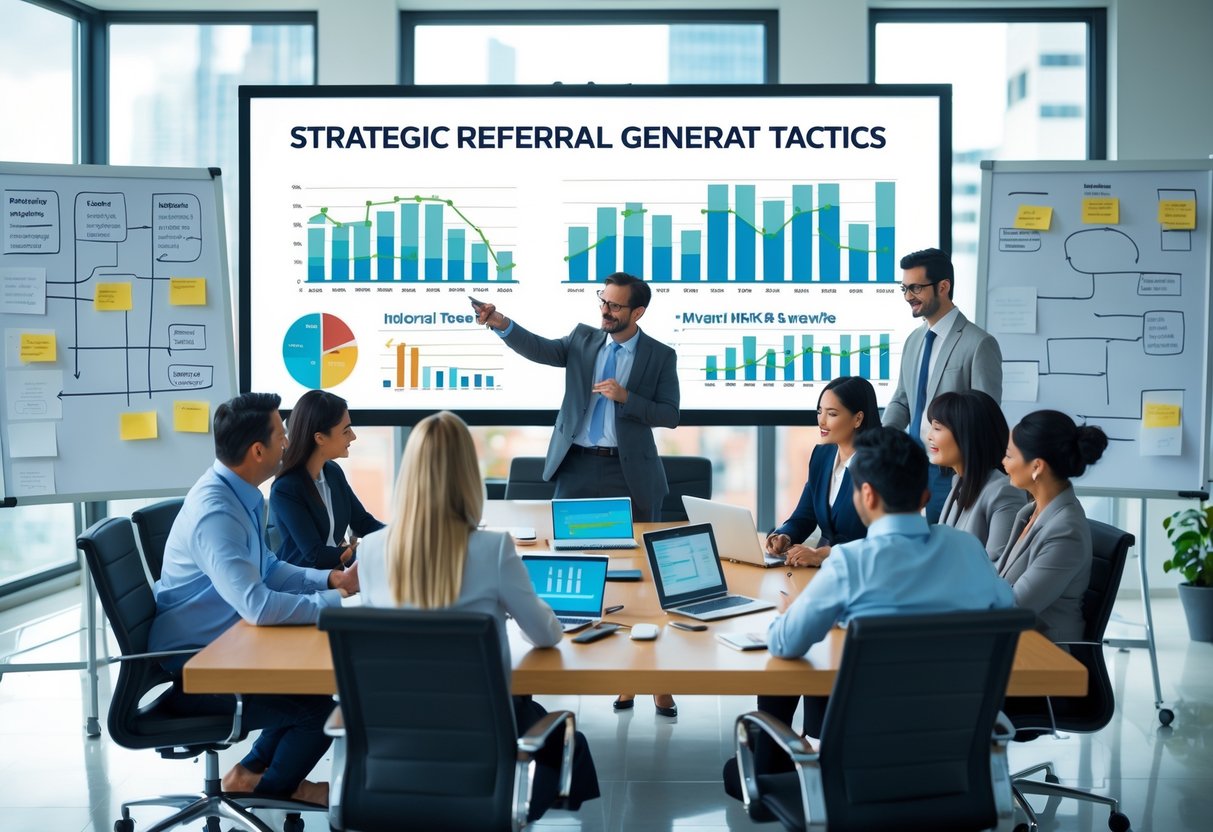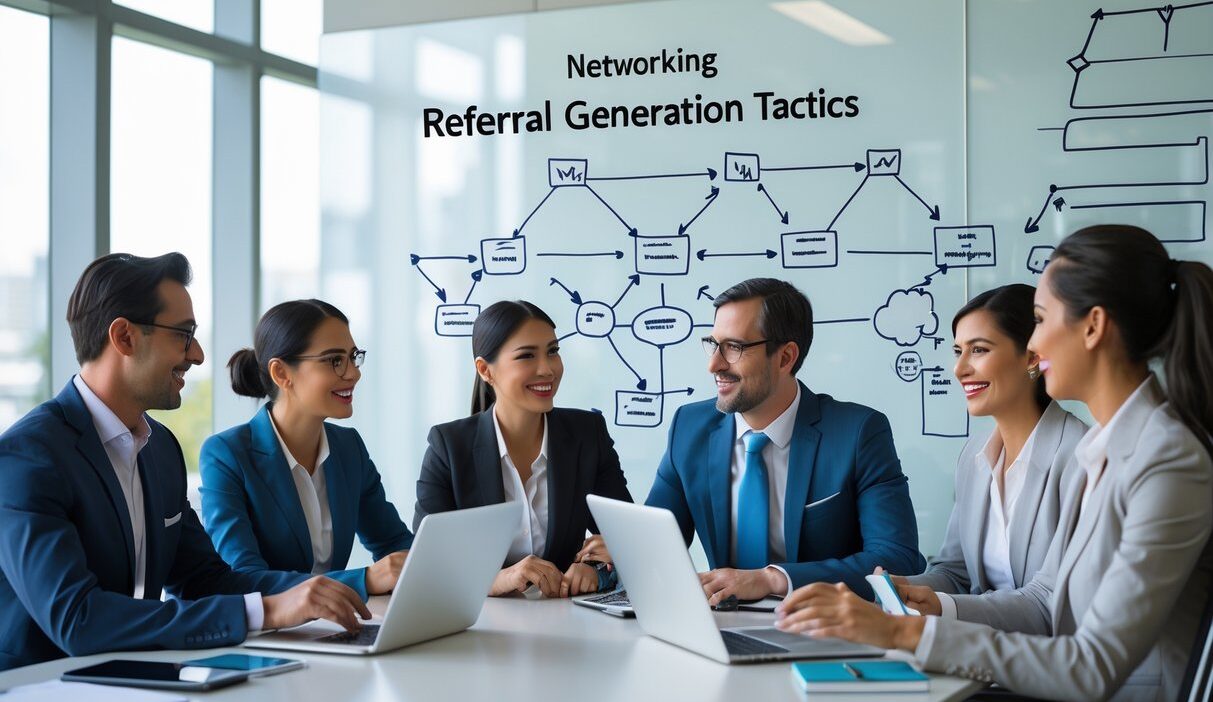Getting new customers doesn’t have to mean pouring money into ads or complicated campaigns. The best growth often comes straight from people who already trust you.
Referral generation tactics let you turn happy customers into a steady stream of new opportunities.

I like to keep things simple—just make it easy for people to share your stuff. Give them a reason, remove any hassle, and you’ll see referrals start to happen on their own.
This approach slashes acquisition costs and brings in customers who stick around longer. It just works.
You’ll find out how to design programs that match your goals, track what’s working, and keep tweaking things for even better results.
Key Takeaways
- Strong referral growth comes from clear principles and really simple systems
- A smooth customer experience makes sharing happen naturally
- Measuring and tweaking your tactics is how you win long-term
Core Principles of Referral Generation
I stick with referrals because they’re cost-effective, bump up conversion rates, and build real loyalty. When I look at how trust and influence shape word-of-mouth, it’s obvious why referral programs beat old-school marketing.
Why Referrals Drive Business Success
Referrals just work better than paid ads. Referred customers usually convert more because they already trust the person who sent them.
Lower acquisition costs and higher lifetime value? That’s what you get.
I love how referrals set off a chain reaction. One happy customer tells a friend, that friend tells someone else, and suddenly you’ve got a flow of warm leads—no big marketing spend needed.
Why referrals rock:
- Cheaper to get new customers
- More loyal clients
- Stronger customer relationships
If you keep it simple and reward people, they’ll keep bringing you business. That’s the secret sauce.
The Psychology Behind Word-of-Mouth Marketing
Word-of-mouth works because it taps into basic human nature. People like to share good stuff, especially if it makes them look helpful.
A referral isn’t just a transaction—there’s a bit of pride and care in it. When someone’s genuinely happy, they want others to feel it too.
Sure, incentives like discounts help, but honestly, emotional satisfaction drives most sharing. If you make people feel good, they’ll want to spread the word.
That’s why referrals beat cold outreach almost every time. It’s real, it’s personal, and customers do the talking for you.
Trust, Social Proof, and Influence
Trust is everything in referrals. If a friend vouches for something, you’re way more likely to try it than if you just see an ad.
Social proof matters too—think reviews and testimonials. They show others have had a good time, so why not you?
Online reviews and testimonials are basically passive referrals. They give people confidence before they even talk to you.
Influence counts as well. Customers with big networks—or even small, tight ones—can spread your reach way beyond what you could do alone.
When you mix trust, social proof, and a little influence, you get a referral engine that keeps your business growing.
Building a Referral-Ready Customer Experience

I’m all about making customers feel valued and motivated to share. If you focus on great service, real satisfaction, and open feedback, referrals start to happen on their own.
Delivering Exceptional Customer Service
Customer service comes first. I make sure every interaction is clear, respectful, and fast.
People who get good support trust you more—and they’ll tell others.
My team listens, solves problems quickly, and offers support through phone, email, or chat. Customers can reach me however they prefer.
I keep an eye on response times and follow up with surveys. That’s how I spot where we can do better.
If you nail customer service, people stick around and actually want to refer you. It’s that simple.
Fostering Customer Satisfaction and Loyalty
Referrals depend on satisfied customers. If people see real value, they’ll stay loyal and recommend you.
I make sure to deliver what I promise—and sometimes a bit more. Things like loyalty programs or small thank-yous go a long way.
I check in regularly and ask for feedback. If something’s off, I fix it fast.
This way, people trust me and feel good about sending their friends my way.
Encouraging Positive Feedback
I always ask for feedback. Positive reviews and testimonials are gold—they convince new prospects and show you’re the real deal.
I make it easy for customers to leave a review or testimonial. I thank them, no matter what they say.
Highlighting positive feedback on my site or socials builds trust and shows I appreciate my customers.
It keeps people engaged and makes them more likely to refer others.
Designing Effective Referral Programs
I design referral programs that are easy to join, have clear rewards, and motivate both new and existing customers. If it’s confusing, people won’t bother.
Types of Referral Programs
I pick the program type based on what my customers like and what fits my business. Single-sided programs reward just the referrer or the new customer—simple, but maybe not super exciting.
Double-sided programs give something to both sides. That’s what most people prefer now, and it gets more signups.
Some programs use tiers—bigger rewards for more referrals. Leaderboards add a bit of friendly competition.
Gated programs keep it exclusive to verified customers, while ungated programs let anyone join (but you’ll need to watch out for fraud).
I match the program to my strategy, weighing how much it’ll cost and how many people will actually use it.
Incentives and Rewards Structures
The reward is what gets people moving. I use cash, discounts, loyalty points, or free products.
Cash is easy but doesn’t build much loyalty. Discounts and points get people to buy again, which is great for retention.
Sometimes I use milestone rewards—like a bonus after three referrals. It keeps people coming back for more.
Here’s a quick look:
| Reward Type | Strengths | Weaknesses |
|---|---|---|
| Cash | Simple, everyone likes it | Can get expensive, not personal |
| Discounts | Drives repeat sales | Only works if they want to buy again |
| Loyalty Points | Builds retention | Not always exciting |
| Free Products | Gets people using your brand | Not as flexible |
I always try to match the reward to what my customers really want—not just what’s cheapest for me.
Simplifying the Referral Process
If it’s a pain to refer, nobody will do it. I keep things super simple: share a link, friend signs up, both get rewarded.
Everything’s mobile-friendly, since most people share from their phones. I make landing pages clean, with a clear call-to-action.
I slip referral prompts into post-purchase emails or dashboards. The easier it is, the more people will actually refer.
Less friction = more referrals. That’s the rule.
Strategic Referral Generation Tactics

I build strong referral systems by picking the right partners, using digital tools, and personalizing every ask. That’s how I boost lead generation and keep everything focused on my target market.
Identifying Ideal Referral Partners
First, I figure out who my best referral partners are. They should serve the same kind of people I do, but not compete with me.
A web designer and a marketing consultant, for example, can swap leads because they help the same clients but in different ways.
I look at three things:
- Reputation: Are they credible?
- Audience fit: Do they reach the people I want?
- Commitment: Will they actually send referrals?
I set clear expectations upfront. I tell them what leads I want and ask them what they need in return.
Good partners send me quality leads and boost my reputation with new audiences.
Leveraging Social Media and Digital Channels
Social media makes referrals easy and visible. I use LinkedIn, Instagram, and Facebook to share referral links, shout out partners, and post client wins.
Referral programs in email campaigns work well too. Simple codes or links make sharing effortless.
Analytics help me track which channels bring the best leads. I focus on what works and drop what doesn’t.
No point wasting time on stuff that doesn’t deliver.
Personalizing Referral Requests
I never copy-paste the same request to everyone. Timing and personalization matter.
I ask for referrals right after a client’s had a good experience—maybe after a project wraps up or when they say something positive.
I’ll send a quick message, short email, or even call. I make it specific: “Know any business owner who needs marketing help? I’d appreciate an intro.”
Tailored incentives help too. Some people want discounts, others like exclusive perks.
Personal touches show I care and make people more likely to send good leads my way.
Optimizing and Measuring Referral Performance

I rely on data to see how my referral campaigns are performing. Tracking the right stuff helps me spot what’s working, where things drop off, and which ideas to double down on.
Tracking Referral Metrics
I watch the share rate—how many customers actually share my referral program. High share rate? That means people are engaged.
Then there’s the referral conversion rate—how many referred leads turn into paying customers. That’s the real test.
To see if it’s worth it, I track referral revenue and compare it to what I spend on the program. Referral software makes this easy.
Tools like Partnero help me see customer lifetime value and retention rates, so I know the long-term impact.
If you’re tired of chasing cold leads or wasting money on ads, just let me handle it. I’ve got proven referral systems and a steady supply of high-quality leads.
Why work so hard? Feel free to contact me on Whatsapp for a quick consultation or to buy leads: +917303556188. I’m always happy to chat, and honestly, it’s just easier to get in touch and let me do the heavy lifting for you.
Improving Conversion Rates
I improve conversion rates by testing small tweaks in my referral campaigns. Sometimes I’ll compare different rewards—cash, discounts, or loyalty points—to figure out what actually gets people moving, both the referrer and the new customer.
Clear communication matters a lot. I keep referral messages short, easy, and super clear about what’s in it for them.
A/B testing helps me play around with subject lines, landing pages, and calls to action. If the onboarding flow for referred customers feels clunky, conversion rates just tank.
So, I go in, trim unnecessary steps, and try to remove anything that slows people down. The simpler the process, the more likely those leads actually buy.
Honestly, if you’re tired of testing and tweaking all this yourself, just reach out on Whatsapp (+917303556188) if you want to buy high-quality leads or need a bit of advice. Why stress over this stuff when you could just get it done right? Feel free to contact me anytime.
Scaling Successful Tactics
Once I see something works, I double down and scale it up. If a certain incentive gets more people involved, I roll it out on more channels—email, social media, even in-app notifications.
I keep an eye on the referral growth rate to track how fast referrals are bringing in new customers. This helps me decide where to put more budget.
If referrals are cheaper and bring in better customers than other channels, I push the program even harder. Talkable’s guide on referral KPIs backs this up—focusing on what works just gets better results as you grow.
Expert Insights and Future Trends
I’m always looking for practical moves that actually tie referral marketing to real growth. The best insights? They come from frameworks that work, new tech, and just paying attention to how people make decisions these days.
Lessons from John Jantsch
John Jantsch’s stuff sticks with me—he’s all about trust and consistency. He says referral marketing shouldn’t be an afterthought; it should be baked into the customer journey from the start.
His advice? Build systems, not just random campaigns. I map out the spots where asking for a referral feels natural, so the whole thing is repeatable and easy to track.
He also talks up customer retention. Happy, loyal customers are always the most likely to refer, so I focus on delivering a great experience first, then ask for referrals once they trust me.
Emerging Technologies in Referral Marketing
Automation and personalization are changing the game. I use tools that track referrals in real time, segment customers, and send messages right when they’ll matter most.
Current referral marketing insights show businesses using A/B testing and predictive analytics to fine-tune campaigns across email, social, and mobile.
AI’s starting to play a bigger role too. It can suggest when to nudge a customer for a referral or predict who’s most likely to say yes. Less wasted effort, better conversion rates.
Referral marketing software is everywhere now, and it’s only getting bigger. These tools cut down the manual work and make the referral process smooth for everyone.
Adapting to Evolving Consumer Behaviors
I pay close attention to how trust works these days. People lean way more on peer recommendations and user-generated content than anything a brand claims.
The numbers don’t lie—word-of-mouth marketing drives trillions in spending. That’s just wild.
Younger buyers especially go for micro-influencers and real voices, not celebrities. So, I shift my referral strategy to spotlight real customer stories and encourage everyday sharing.
Retention is huge here too. Referred customers stick around longer and spend more, so I pour energy into making sure customers feel valued. When they do, they naturally bring in new business.
Frequently Asked Questions
I stick to clear, actionable steps for making referral programs work—right rewards, the right tools, and just using smart timing and communication.
What are effective strategies for increasing referral marketing success?
I use rewards that appeal to both the referrer and the new customer. Timing’s key—I ask for referrals when customers are happiest, like after a good purchase or service.
I also make it dead simple with shareable links or codes.
Can you provide examples of successful referral marketing campaigns?
E-commerce stores have grown fast with referral marketing strategies that give discounts to both sides. Subscription services often hand out free months for each referral, which keeps people coming back.
Food delivery apps? They crush it by giving credits to both the referrer and the new user.
What are the best practices for asking for referrals without being intrusive?
I ask at natural points—after a positive review or a repeat purchase. I keep my request short and focus on what’s in it for them.
Gentle reminders in emails or apps keep it visible but never pushy.
How can a business incentivize existing customers to generate more referrals?
Cash rewards, discounts, and freebies always work. A points system can motivate people too, letting them earn and redeem over time, as you’ll see in referral generation strategies.
Exclusive access or early product releases also get people excited.
What are the key elements to include in a referral program?
I always make sure there’s a clear reward, simple sharing tools, and honest tracking. Customers should know exactly what they’ll get and when.
The program should be easy to join and work on email, social, and apps.
If you’re sick of figuring all this out by yourself, honestly, just message me on Whatsapp at +917303556188. I’ll make it easy for you, whether you want to buy leads or just need some advice. Why work harder than you need to? Feel free to contact anytime.
How can online platforms be leveraged to automate and track referral processes?
Honestly, I just use referral software that spits out unique links or codes for every customer. It tracks sign-ups, conversions, and handles rewards for me—no need to babysit the process.
Most of these platforms throw in analytics, so I can see who’s really bringing in results and who needs a little nudge. If I want to tweak incentives or just see what’s working, it’s all right there.
Look, why stress over figuring this out yourself? If you want leads or just want to talk strategy, feel free to contact me on WhatsApp at +917303556188. It’s way easier to let someone who’s already done the heavy lifting help you out.



